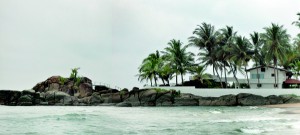News
White house on beachrock above the law
View(s):Residence reportedly belonging to Presidential physician and spiritual healer Eliyantha White raises questions
By Charundi Panagoda
Under the Coast Conservation (Amendment) Act No. 64 of 1988, all construction along the coast must be built 45 metres away from the vegetation line. No building is allowed on the beach. Regardless, in scenic Ahungalla about 200 metres from the Heritance Hotel, is a modern-looking house right on the beach.
One section of the house is built on the rock with railings and other constructions overlooking the ocean. The private property obstructs the beach, especially when the tide is high and no one can walk around the rock. Recently, Coast Conservation officials have brought down a number of encroaching establishments along the Ahungalla beach and islets, but the house on the beachrock, which locals say belong to Presidential physician and spiritual healer Eliyantha White, survived.
Balapitiya Area Coast Conservation Officer C.K.A Kumara said the building has a permit from the Department of Coast Conservation (DCC) obtained in 2004. Initially, the permit used was for an old building at the site, as the Coast Conservation law does not apply for buildings constructed before 1984. “But the owners said the old foundation was not strong enough for a new two-storey building, and they have obtained special permission from the DCC Advisory Committee for this house,” Mr. Kumara said.
DCC Deputy Director General Gamini Hewage said the Advisory Committee, chaired by Defence Secretary Gotabaya Rajapaksa, has the power to relax the 45-metre build zone rule. The law is mostly relaxed for hotels and fishery-related buildings, and occasionally private residences.
“It is subject to a case-by-case basis, on land value and how big the hotel or the house is. The Advisory Committee can relax the 45-metre limit up to about 20 metres, given there’s no coastal damage. But nothing can be built on the beach,” Mr. Hewage said.
Most of the constructions along the coastal areas of Sri Lanka are illegal, said Sevvandi Jayakody, Wayamba University’s Senior Lecturer in Aquaculture and Fisheries. On the short term, illegal constructions increase the risk of erosion. Also, in most cases, these constructions don’t have proper sewage disposal and untreated sewage ultimately ends up in the sea, not only polluting the water, but creating large masses of slowly decaying floating material that releases toxins into the water.
“In the long run, gradual erosion could lead to changes in the configuration of Sri Lanka, and gradual pollution of water could change our ecological system, affecting fishery activities,” Dr. Jayakody said.
In some cases, the DCC cannot remove these illegal constructions, especially if they are shanties belonging to poverty-stricken families.
“In Moratuwa area, there are some illegal buildings, but considering the humanitarian aspect, we can’t demolish buildings belonging to people who have nowhere else to go. But if they are hotels or commercial-type buildings, we take action,” Mr. Hewage said.
Balapitiya Pradeshiya Sabha Chairman Dayaratna de Silva declined to comment.
Follow @timesonlinelk
comments powered by Disqus



















